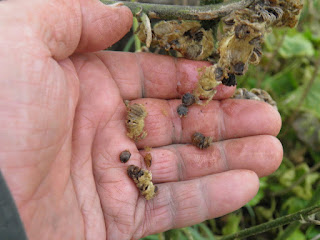Here are some thoughts about fall planting that I wrote about recently for an area newspaper. I describe our current customer profile at the flower farm and some considerations as you plan for a new garden--either by your own design or with design assistance from someone with different experience. Give us a call if you have some ideas that need our confidence 802-426-3505. Leave a message if you miss us.
THAT
NEW GARDEN
November 2018 was an unusually different kind of month
as rain and winds turned white and cold early, and record setting snow piled
higher than we remembered. Gail and I received many phone calls and emails from
gardeners who had ordered bulbs and perennial plants including peonies which
never arrived until we were well into November. Some called with questions such
as “There’s snow on the ground, can I plant bulbs? Can I still plant peonies
that just arrived? Can I still dig my dahlias and glads (or are they dead)? Is
it still ok to prune my hydrangeas? When can I prune my apple trees? We said
“yes” many times along with words of encouragement to get going.
As I reflect on questions gardeners asked during the
past summer, I keep returning to thoughts of the people with the gardening
questions…the actual people themselves. At the flower farm I try to track where
people come from, their age and their gardening experience. When we first moved our flower farm down from
Peacham Pond Road to Route 2, I was taken by visitors arriving in cars and
trucks with Maine license plates. Over time I determined that more than 15% of
our customers were from Maine and many had used Route 2 to travel to Burlington
to visit the airport, the hospital, one of the educational institutions (kids
in college) or to work at remote offices. The numbers were significant because
they represented more people from far away Maine than from nearby Montpelier or
Barre. In addition to my findings on source of customers, I confirmed what many
in the horticultural field had already determined—that the average customer to
a modern day nursery is a 55 year old woman. Finally, I tracked new homes,
either newly built or newly purchased homes. Significant was that it was
usually in year two or three after arrival that homeowners visited the nursery
to seek landscape design advice and begin making purchases. To us this was
important because of the number of new property owners we regularly met from
the towns of Newbury, Barnet, Peacham and Danville, Vermont as well as Hanover,
Orford, Haverhill, Monroe, Woodsville, Bath, Lisbon, Littleton and Lancaster,
New Hampshire.
The customer profile might not seem important but the
inherent message to you the gardener might be. It’s a message I try to
tactfully work into garden design requests. In a world where age discrimination
is well known to us, I ask realistic questions about the gardener, who will
build or renovate the gardens if we
design them, and who will handle the maintenance to keep things looking nice
after the initial planting. I also try to get a handle on how long people
intend to stay at their property, is the home a permanent or seasonal home, and
is the landscaping plan really intended to encourage resale at increased profit
in the short term.
Attractive gardens which bring us nice compliments
require an investment of time and other resources. As such it’s best to do
things correctly from the start. If you are thinking about doing some landscape
work at your home next year, do you want to do most or all of the work or do
you prefer to hire the work done for you. Consider whether you will provide
ongoing maintenance or whether this is something you also wish to hire out.
Define what you would like to see in general terms and ask a designer to give
you a ballpark cost estimate. This will narrow the opportunity for surprises.
Winter is a good time to work on design ideas you have
in mind. If the snow isn’t too deep yet, take some pictures of the areas you
want to change. Always include any adjacent buildings and trees in pictures so
shadows and summer light conditions can be calculated. Make notes of any
underground services such as water lines, electric, gas, sewer,
telephone/television cable, electric generator, and solar array lines. If you
have any experience with underground ledges or large boulders that you are
aware of, make note of them before beginning to design. Be confident that you
can collect much of this information yourself and that it’s all important to
whoever you might work with to finalize a plan. If you have questions, give us
a call at 802-426-3505 and we’ll help. We love to see great gardens—and smiling
gardeners!!









































